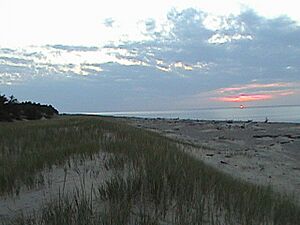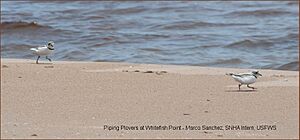Whitefish Point Bird Observatory facts for kids
Quick facts for kids Whitefish Point Bird Observatory |
|
|---|---|

Bird watching station at Whitefish Point
|
|
| Organization | Michigan Audubon Society |
| Location | Chippewa County, Michigan USA |
|
Coordinates
|
46°46′14″N 84°57′24″W / 46.77056°N 84.95667°W
|
| Established | 1978 |
| Website www.wpbo.org |
|
The Whitefish Point Bird Observatory (WPBO) is a special place in Chippewa County, Michigan, USA. It's right next to the Whitefish Point Unit of the Seney National Wildlife Refuge. This observatory is a non-profit group that works with the Michigan Audubon Society.
Together, they have seen over 300 different species of birds at Whitefish Point. The WPBO is part of a big network of bird observatories across Canada. It helps track bird populations in the Great Lakes area. They do this by bird banding, collecting information, and doing research.
Contents
Discovering Whitefish Point's Bird History
Bird lovers started a project at Whitefish Point in 1966. They wanted to study hawks migrating in the spring. Later, they also began watching migrating owls. This early project helped lead to the creation of the WPBO.
The Michigan Audubon Society worked to get permission to use the U.S. Coast Guard's Whitefish Point Light Station in 1976. The only parts they couldn't use were the automated light and foghorn.
The WPBO officially opened in 1978. It's a non-profit group that gets help from members, donations, and volunteers. It also receives grants from different organizations.
WPBO started watching spring bird migrations every year in 1979. By 1989, they also began watching fall migrations. They added more educational and research activities too. In 1998, Michigan Audubon received ownership of some land at the old light station. The WPBO now uses this land for its research and education programs.
Researchers at Whitefish Point face tough weather. So, they learned from observatories in Britain. These places use small buildings where people can stay to watch birds. This helps them keep records and report what they see during migration.
Why Whitefish Point is Important for Birds
The American Bird Conservancy has called Whitefish Point a Globally Important Bird Area. This means it's a very special place for birds around the world. The land and water here create a natural path for thousands of birds. They use it during their spring and fall journeys. This makes it a great spot for studying birds, teaching people, and helping protect them.
Many amazing birds can be seen here during migration. These include golden eagles, peregrine falcons, merlins, boreal owls, and great gray owls. You might also spot red-throated loons, red-necked grebes, scoters, and jaegers (also known as skuas).
Thousands of birds stop at Whitefish Point to rest and refuel. They need to gather energy before flying across Lake Superior. A study by WPBO found that most migrating landbirds stay close to Whitefish Point. They prefer areas along the shore.
The piping plover is a federally endangered bird. This means it's in danger of disappearing. For the first time in 23 years, a pair of piping plovers nested at Whitefish Point in 2009. They successfully raised three chicks! By 2012, three piping plover nests were found here. The sandy, rocky beaches at Whitefish Point are perfect for these birds to lay their eggs. The U.S. Fish and Wildlife Service has protected about 2.5 kilometers (1.5 miles) of Whitefish Point's shoreline. This gives the piping plover special protection under the Federal Endangered Species Act.
Bird Research Programs at WPBO
Meet the Bird Experts: Staff and Volunteers
During migration seasons, WPBO has a team of paid staff. This includes a bird scientist, owl banders, and people who count waterbirds and hawks. They also have a gift shop manager. Experienced bird watchers lead trips to some of Michigan's best birding spots. There's also an event called "Spring Fling" that celebrates bird migration each year.
Counting Migrating Hawks and Eagles
Experts at WPBO count migrating hawks, falcons, and eagles every day. This helps them track how raptor populations are changing over time. The daily count happens at the "Hawk Dune." This spot is about 200 meters (656 feet) west of the Whitefish Point Lighthouse. It's also about 20 meters (65 feet) above Lake Superior.
Raptor banders have special licenses from the U.S. Fish and Wildlife Service (USFWS). They use nets to gently catch birds from the sky. Each bird is quickly banded and then released. They record details like the date, time, location, species, age, and sex of the bird. Researchers noticed more merlin falcons being caught in 2004. This showed that merlins were recovering after a ban on the pesticide DDT.
Studying Owls: Nighttime Migrators
WPBO also studies migrating owls in spring and fall. They use special nets called mist nets. They also study young northern saw-whet owls in the summer.
A 20-year owl banding project has become even more successful. They now use audio lures to play owl calls. This helps them catch eight times more owls! Owls are caught in nets that are about 3 meters (10 feet) high and 7.6 meters (25 feet) wide. These nets are set up in clearings among the trees. After recording information, the owls are released.
Researchers say that almost one-third of all boreal owls banded in North America were banded by WPBO. Whitefish Point might even have the biggest and most diverse owl migration in North America.
Watching Waterbirds: Lake Superior's Visitors
Whitefish Point is a key place for tracking waterbird movements in the upper Great Lakes. The Audubon Society reports that between 18,000 and 21,000 red-necked grebes fly past the point each fall. This is about 25–40% of all red-necked grebes in North America! Other birds counted in large numbers include the common loon, red-breasted merganser, common tern, and Bonaparte's gull.
Waterbirds are counted during both spring and fall migrations. The count happens on the beach near the tip of Whitefish Point. It starts at sunrise and lasts for eight hours. More birds are often seen on stormy days. However, Whitefish Point often has fog, which makes counting difficult.
Protecting Shorebirds: The Piping Plover's Comeback
In 2009, piping plovers nested at Whitefish Point for the first time in 23 years. They successfully raised young birds! By 2012, three pairs of plovers nested here and raised eleven young. In 2010, the National Fish and Wildlife Foundation gave a grant to Lake Superior State University. This money helped them closely watch nesting piping plovers at Vermilion, Whitefish Point, and other areas.
The USFWS has marked the shoreline from Whitefish Point to Grand Marais, Michigan as important habitat for the piping plover. The piping plover population in the Great Lakes is small and very vulnerable. On August 30, 2012, the USFWS added more land and shoreline at Whitefish Point to protect these birds.
Counting Songbirds: Small Birds, Big Journeys
The observatory also counts migrating passerines (songbirds) at the Point. They also study songbird populations across the Upper Peninsula. They pay special attention to rare species and birds that migrate to warmer places for winter. The daily songbird count is combined with the hawk and waterbird counts. This helps them estimate the total number of all species migrating through Whitefish Point each day.
WPBO's Role in a Big Bird Network
The Whitefish Point Bird Observatory is the only U.S.-based bird observatory in the Canadian Migration Monitoring Network. This North American network of observatories studies and tracks huge amounts of information about migrating birds. They share this data from the Atlantic to the Pacific. This helps them see the "big picture" of what bird populations are doing across the northern half of North America.
Images for kids






